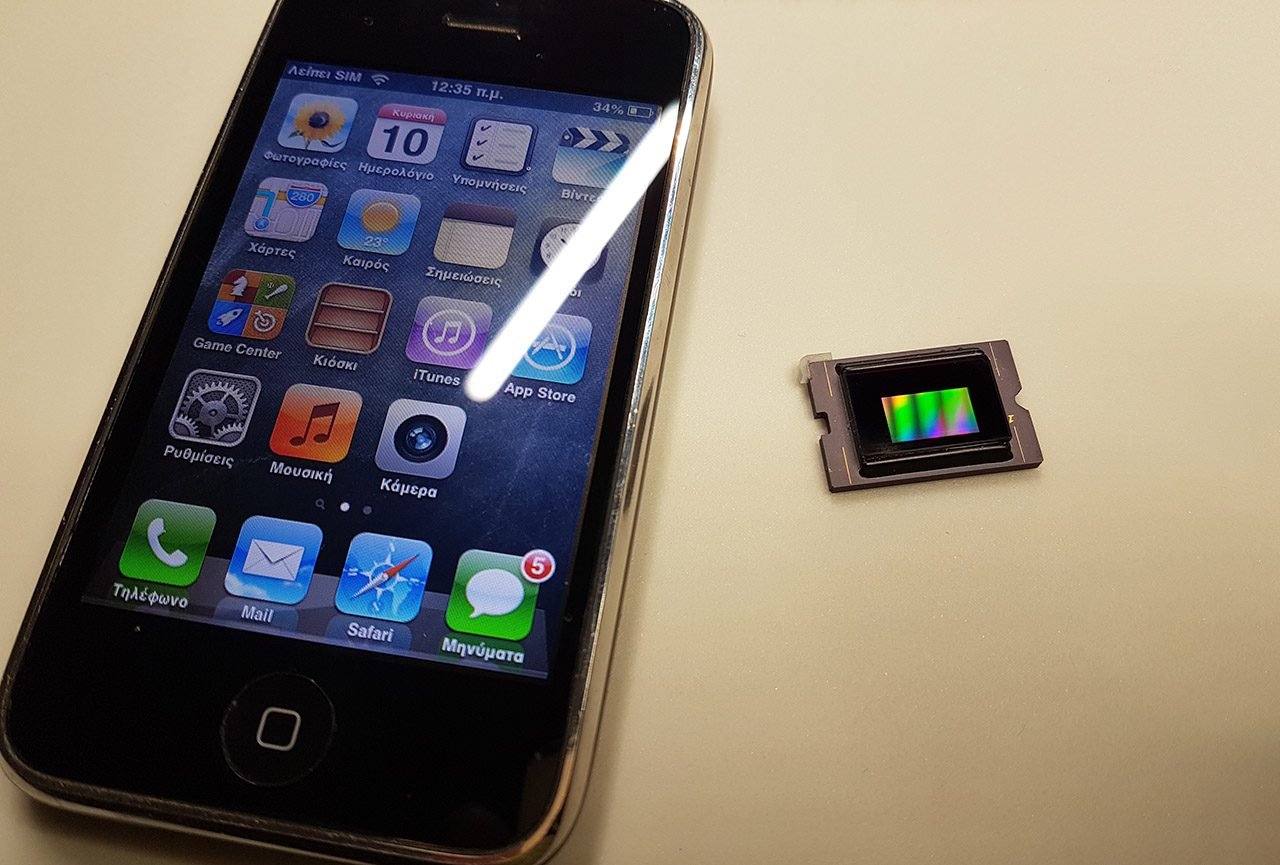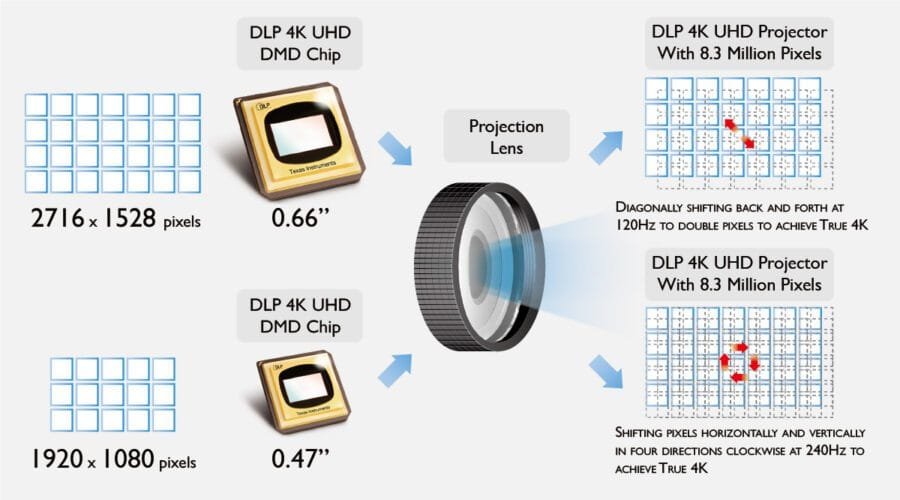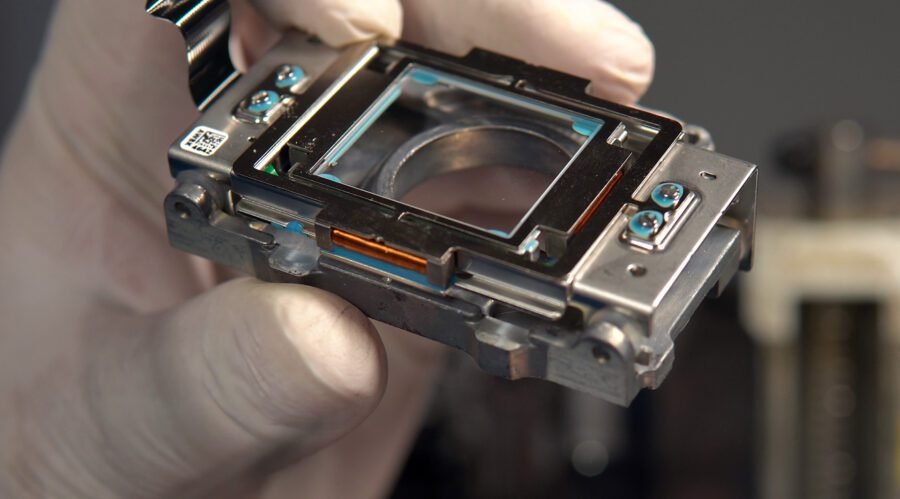In the beginning of DLP 3D-printers, the jargon were quite easy. There were mainly HD projectors available and in some exotic models, the manufacturers chose for a 4K DLP projector. In today’s hardware and material landscape, the different techniques and marketing expressions are endless and sometimes confusing. In this article we explain the differences in technology in hardware and materials.
HD vs 2K vs 4K vs 8K imaging hardware resolution
The naming of the resolution of the DLP and LCD screens come from the general hardware and display industry. It has to do with the amount of lines and pixels available within one screen / projection. Originally there were 2 options, 720P (HD ready) and 1080P (Full HD). These resolutions are mainly used in DLP techniques. For instance the Asiga Max, Atum3D DLP Station 5, Miicraft Hyper series and 3DSystems Figure 4 use a full HD (1080P; 1920*1080 pixel) DLP module. For years (and maybe still today) this was the most used DLP module. Some older model DLP printers, and the newly announced Anycubic Photon Ultra use a lower resolution 720P DLP.

Image by thinkware.com: difference between 720P, 1080P, 2K 4K and 8K resolution in screen technology.
What about resolution in 3D-printing?
Looks quite simple right? Let’s look how this translates to resin 3D-printing hardware. In the table below you can find the resolution according to the 3D-printer manufacturer and actual pixel size of popular 3D-printers. In the 720P and HD resolution everything is matching quite well with the technical specifications used in the display industry. From 2K resolution and higher, it gets mixed-up.
Table 1: Resolution and pixel size of popular resin 3D-printing brands and technologies.
| Resolution | Pixel size | Brand, Model & technology |
| 720P | 1280 * 720 | Anycubic Photon Ultra (DLP) |
| 1080P / HD
|
1920 * 1080
|
Asiga Max (HD DLP)
Atum3D DLP Station 5 (HD DLP) Miicraft Hyper series (HD DLP) 3D-Systems Figure 4 (HD DLP) RapidShape I30+ / HA30+ / S30+ / D30+ (HD DLP) Phrozen Sonic Mini (LCD) |
| 2K
|
2560 * 1440
|
Anycubic Photon S (2K LCD)
Elegoo Mars (2K LCD) |
| 2560 * 1620
|
Anycubic Photon Mono SE (2K LCD)
Elegoo Mars 2 & Mars 2 Pro (2K LCD) |
|
| 4K
|
3840 * 2400
|
Anycubic Photon Mono 4K (4K LCD)
Anycubic Photon Mono X (4K LCD) Phrozen Sonic Mini 4K (4K LCD) Elegoo Saturn (4K LCD) |
| 4098 * 2560 | Elegoo Mars 3 (4K LCD) | |
| 3840 * 2160[1]
|
RapidShape I50+ / HA50+ / S50+ / D50+ (4K DLP)
Miicraft Profession series (4K DLP) Nexa3D NXE 400 (4K LCD) |
|
| 3650 * 2300 | Nexa3D XiP (4K LCD) | |
| 2960 * 1660 (XPR[2])
|
ETEC / EnvisionTEC D4K (4K DLP)
Miicraft Prime series (4K DLP) |
|
| 2716 x 1528 (XPR[2])
|
Asiga Pro 4K (4K DLP)
UnionTech Cute 300 (4K DLP) |
|
| 6K | 5760 * 3600 | Anycubic Photon Mono X 6K (6K LCD) |
| 5448 * 3064 | Elegoo Jupiter 6K (6K LCD) | |
| 8K | 7700 * 4300 | Phrozen Sonic Mega 8K (8K LCD) |
| 7500 * 3300 | Phrozen Sonic Mini 8K (8K LCD) | |
| 3840 * 2160[3] | ETEC / EnvisionTEC Extreme 8K (2x 4K DLP) |
[1] Not clear from the data if a 4K (3840 * 2160 pixels) chip is used, or a XPR chip with lower resolution and pixel manipulation
[2] XPR is used to manipulate pixels of a 2960*1660 or 2716 * 1528 chip to 4K (3840 * 2160 pixels)
[3] Likely two 4K projectors
Let’s focus first on LCD technology, as this is easiest to explain. As you can see in the table above, there are several configurations possible for 2K, 4K, 6K and 8K LCD screens. The number before the “K” is often matched to the amount of pixels in the width. The 8K LCD screens used in 3D-printing in the Phrozen Sonic Mega 8K and Mini 8K have respectively 7700 * 4300 and 7500 * 3300 pixels. All mentioned in the marketing term “8K resolution”. The amount of pixels, divided by the width is the pixel size. This is often seen as the accuracy factor in 3D-printing. The Mega 8K and Mini 8K have quite similar amount of pixels, but the screen of the Mega 8K is much bigger giving it a pixel size of 0,043 mm while the mini 8K is much smaller and also has a smaller pixel size of 0,022 mm. What about 4K DLP printers?
Why is there a difference in 4K DLP resolution?
This is much more difficult to explain. High resolution true 4K DLP projectors have been around for a while, used in industrial applications like cinema’s. The pricing of a true 4K DLP with 3840 * 2160 pixels has always been very high and often not used in 3D-printing. Since some years, DLP manufacturers have invented a method to make the 4K DLP systems cheaper by pixelshifting HD resolution into a 4K image. There is a controversy ongoing if this can be named 4K, because the pixel amount from the DMD chip is not really 3840 * 2160. If you have the time, an interesting read by Evan Powell from projectorcentral.com can be found here.
Let’s go back one step. In a DLP 3D-printer, one or more LED’s are emitting light on a DMD chip. This DMD chip is made out of micro-mirrors. These mirrors can be switched on or off for each mirror. If a mirror is switched on, the light will be exposed to the build tray in the 3D-printer. When a mirror is switched off, it will not be exposed. A Full HD DMD chip is made from 1920*1080 pixels. All these 2 million pixels / micro-mirrors can be switched on or off individually. Giving a HD resolution to the image. It is truly fascinating how small a DMD chip is with its 2 million micro-mirrors.

Image by projectorjunkies.com: famous 0.47” DMD chip which gives a Full HD projection (1920*1080 pixels).
To get a higher accuracy, you can add pixels to the DMD chip. As this is a complicated and expensive process, the prices go up significantly. An cheaper way to do this is to manipulate the pixels of a smaller DMD chip to reach 4K quality. They manipulate a 0.66” (2716*1528) DMD chip or a 0.47” (1920*1080) (Full HD) DMD chip to a 4K resolution(3840* 2160) image. Nikos Tsolas from Projectorjunkies.com explains this here. It is called XRP technology. This brings down the pricing to <$6900 for a 4K DLP projector.
Nikos explains ”XPR technology is what has allowed the DLP projectors of the last years to be called 4K and advertised as 4K, it is the trick of Texas Instruments we would say to give 4K resolution to the manufacturers of DLP projectors while selling them the classic DMD chip with resolution 1920 × 1080 who has been manufacturing for 10 years now. Let’s go straight to the point and find out how XPR technology works and many questions will be answered.”

Image by projectorjunkies.com: manipulation of Full HD and 2716*1528 DMD chips to 4K UHD.
What is XRP technology in 4K DLP systems?
Nikos continues ”The XPR module is a very simple but accurate device to conceive and consists of 2 main parts. The optical and the electromechanical part. In the optical part we have a piece of specially processed glass so that it directs the beam of light that receives its call according to the horizontal and vertical axis.

Image by projectorjunkies.com: XRP module to be placed after the DMD chip to shift pixels.
In the electromechanical part we have 4 electromagnets coils that force this piece of glass to change position both in the horizontal and in the vertical axis.”

Read the detailed article here or watch the video:
What does XRP manipulated 4K resolution mean in 3D-printing?
There are a few disadvantages in XRP technology compared to true 4K. Due to the pixels moving all the time, the contrast ratio of XRP is lower and there is a slight blur on the pixel edges. Does this matter for 3D-printing? For 3D-printing it is always good to have a high contrast ratio of your projector. A high contrast ratio means that the unexposed pixels are truly dark while the exposed pixels are very bright. By having a high contrast ratio, a detailed edge accuracy is possible in the 3D-printed part. A lower contrast ratio is not always visible without microscopic imaging. However, high reactive resins might have issues with this, as the dark pixels are not truly dark. After many exposed layers these reactive resins can start to polymerize randomly from the build-up energy of many layers. Then what about the blurry pixel edges? Well, a lot of 3D-printer manufacturers already use blurry pixels on the edges of the part to get a smoother print. When dialed-in properly on the resin this has the potential to work well without issues.
How do I know if a printer has an XRP 4K projector or a true 4K DLP?
This is depending on the data that a 3D-printer manufacturer publishes. Some are quite honest about it. For instance UnionTech has listed the DMD chip (TI DLP660TE) from their Cute 300 industrial 4K printer on their website. When searching on the DMD chip you can find that it is an 0.66” (2716*1528) DMD, meaning it can provide a 4K image by diagonally shifting pixels. ETEC / EnvisionTec is less transparent about it, but with calculating their build envelope (in mm) divided by their native pixel resolution (in mm) you find a DMD resolution of 2960 * 1660 pixels, which is close enough to the 0.66” (2716*1528) DMD chip. While RapidShape does only mention 4K and 3840 * 2160 pixels. Is this a true 4K projector or a XRP 4K DLP?
Is a 2K LCD / MSLA printer more accurate than a HD?
As you expect by now, the answer is much more complicated than the question. First of all, the term 2K LCD or HD Projector does not say anything about the (native) pixel size. Even if you compare a 2K LCD with a HD projector with both a pixel size of 0.05mm, it is difficult to answer this question. If a DLP is produces well, the quality is often better compared to LCD printers.
If you dive deeper in the technical data, much has to do with the hardware in combination with the software, printing parameters and materials. What we have seen from earlier models of LCD printers, is that the edge accuracy was not to great, but in the latest year there has been a lot of improvement on this. What we know from DLP, is that there are much more manipulation options in the software and micro-mirrors possible (if the manufacturer develops this). Building a good DLP 3D-printer, the manufacturer has to make sure that the focus is perfect on top of the resin tank and compensate for the lens and trapezium deformations. If a DLP is produces well, the quality is often better compared to LCD printers.
Is a higher resolution projector / LCD more accurate?
If you rule out all the other factors, a higher resolution projector or LCD is more accurate. Unfortunately in most cases there are also other factors. What we have seen in the past is that within one printer brand, you can compare the specifications quite well. It is difficult to compare specifications from different printing brands. For instance the Phrozen Sonic Mini 4K and the Elegoo Mars 3 are quite similar with both a pixel size of 0.035 mm. With the Mars 3 we get higher quality models compared to the Phrozen Sonic Mini 4K. The LCD screens are different, but also the Mini 4K uses a glass plate on top of the LCD, which reduces the sharpness of the exposed pixels. On paper these differences are difficult/impossible to see.
What are 4k or 8k resins?
With the rise of the 4K and 8K printers, marketing also hits the resin market. For instance Phrozen is now offering a 4K resin and a 8K resin. According to Phrozen; “Phrozen Aqua 4K Resin is designed to showcase 3D models in high resolution and works best with the Sonic Mini 4K & Sonic Mighty 4K 3D Printers. With its special formula, Phrozen Aqua 4K Resin creates high-quality & extremely intricate 3D models with 4K resolution.”
As resin developer and manufacturer, we completely understand that a resin specifically developed for a printer can give great quality. The power of the light source from the printer can be fine-tuned to work best for the resin and visa-versa. This does not mean that if you run it on another 4K printers, you will get the 4K resolution. The resolution comes from the hardware in combination with settings that work well with the resin. With any compatible resin you would be able to get similar resolution printed parts.
Update April 2022 on 4K DLP projectors for resin 3D-printing.
Just a few months after we published this article, Austrian DLP manufacturer In-Vision announced the release of a native 4K resolution projector for 3D-printing applications. Available mid 2022, still a lot of details have to be published.
According to 3Dprintingindustry.com ”Named AVATAR, the light engine is based on a new chipset from Texas Instruments which offers a native resolution of 4096 x 2176, a radical improvement over the current need to re-position WGXGA-Chip pixels to improve image resolution and achieve 4K within DLP Projection.”
We got really excited reading this, but unfortunately there is not much information available about the actual pixel size or an Texas Instruments datasheet. The only information available is that it is based on the TI Chipsets: DLP990U or DLP990UUV and that it will be available for wavelengths 365 nm, 385 nm and 405 nm. According to In-Vision DLP manufacturer “Equipped with the native resolution of 4096 x 2176 offered by Texas Instruments’ new chipset, the AVATAR UV light projector will enable 3D printer operators to expose larger areas at high resolution than before, and to make moving exposures with high optical performance. In addition to its native resolution offering, the system also delivers a number of other key features to facilitate a new level of advanced industrial 3D printing.” If you are really into technology, a nice read about the background and testing done at In-Vision can be found if you subscribe to the whitepaper in this link on the In-Vision website.
We hoped this was an interesting and educational read. Please send us an e-mail at info@liqcreate.com if you have any questions, comments or remarks. We wish you happy printing!
Support
Do you need any help with 3D printing our SLA, DLP or LCD resins? We can help you! Just look for the question you have below. If you can’t find it, let us know by contacting us!


